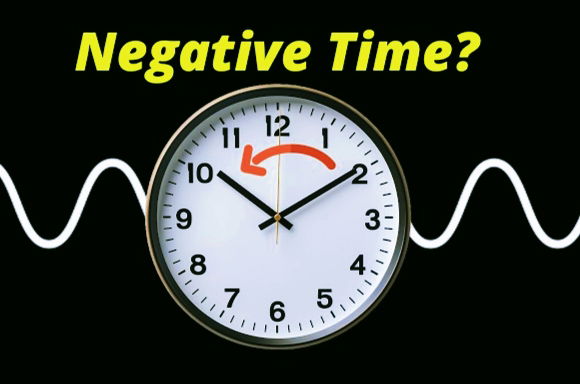
In the realm of physics, time is usually considered an unidirectional flow – from past to present to future – and one of the fundamental dimensions in which the events of the universe unfold. But recently, the concept of “negative time” has started to capture the imagination of both scientists and science fiction enthusiasts alike. But what exactly does negative time mean, and could it really exist?
In this post, we will delve into the concept of negative time, its origins, its potential applications, and whether it has any scientific grounding or remains confined to the realm of theoretical and speculative thought.
What is Negative Time?
At its core, the idea of negative time is fairly simple: it’s the concept of time running backwards. In other words, events happening in reverse chronological order, where future events occur before past ones. This might sound bizarre or even nonsensical at first, but the idea has been explored in both theoretical physics and popular culture.
In Simple Terms
Imagine watching a video on your phone in reverse. The people in the video would appear to be moving backward in time—walking backward, objects going back into their previous positions, and so on. Negative time refers to the hypothetical reversal of this process, where everything happens in the opposite direction from what we perceive as normal time flow.
The Origins of Negative Time
The concept of negative time doesn't originate from any one place or individual, but can be traced back to various areas of thought:
- Mathematical and Physical Theories: In some branches of physics, negative time arises as a mathematical construct. For example, when using certain equations to model the flow of time, scientists may introduce a negative value for time as a way to explore the behavior of systems under different conditions.
- Relativity and Time Reversal Symmetry: In the context of Einstein’s Theory of Relativity, the laws of physics are time-symmetric at a fundamental level, meaning they don’t inherently distinguish between time moving forward or backward. If you were to reverse the direction of time (i.e., change the sign of time in the equations), the laws of motion, electromagnetism, and gravity would still hold, though the interpretation of events would appear “backwards” from a human perspective.
- Quantum Mechanics: Some interpretations of quantum mechanics suggest that particles could theoretically travel backward in time. This is related to a concept known as CPT symmetry (Charge, Parity, and Time reversal symmetry), which suggests that certain physical processes could be reversible when considering both the reversal of time and the reversal of other factors like charge and parity. However, the observable universe doesn’t appear to follow this pattern in any meaningful way.
- Philosophy: Philosophers have long debated the nature of time itself. Some ask whether time is an illusion, and if so, what the implications would be for concepts like "negative time." Philosophers like J.M.E. McTaggart proposed that time itself might not be as linear as we perceive it, and the idea of time reversal or "negativity" may be tied to a deeper metaphysical question.

Does Negative Time Really Exist?
At the present moment, negative time doesn’t exist in any practical, observable form. Time—as we experience it in our day-to-day lives—always moves forward. However, this doesn’t mean that the idea is without merit or relevance to the scientific community. Let’s break down the possibilities:
1. In Classical Physics
In classical mechanics, time is treated as a one-way street. Newtonian physics, for example, assumes that time is always progressing forward. If you were to apply negative time in these models, you'd encounter paradoxes, like objects seemingly violating causality (where an effect occurs before its cause). This makes the idea of negative time unworkable in classical contexts.
2. In Relativity
In the realm of special and general relativity, time is treated as a dimension akin to space, part of the fabric of spacetime. Time in relativity can behave differently depending on your velocity or gravitational field (e.g., time dilation). While relativity allows for some non-intuitive aspects of time—like time slowing down or speeding up for different observers—it doesn’t permit "negative time" in the sense of events occurring in reverse chronological order. However, time reversal symmetry in physical laws means that in some situations, we can mathematically model scenarios where time could be reversed. This does not imply that time physically runs backward but suggests that certain processes might theoretically be reversed without violating physical laws.
3. In Quantum Mechanics
The idea of particles or information moving backward in time arises in certain quantum field theories. The Feynman diagrams used in particle physics depict time as running both forward and backward in order to model certain types of interactions. However, these are often just mathematical tools rather than evidence of time traveling backward in the real world. The role of time reversal in quantum mechanics is still an area of active research, but there is no experimental evidence to suggest that we can observe "negative time" on a macroscopic scale.
4. In Popular Culture
In science fiction and movies, negative time is often portrayed as a potential for time travel or as a way to reverse catastrophic events. Films like Back to the Future or Interstellar depict characters moving backward in time to change past events. These portrayals, while captivating, are pure fiction, as our current understanding of physics doesn’t support such possibilities.
Could Negative Time Ever Be Real?
While current science doesn’t suggest that negative time exists as a physical phenomenon, this doesn't mean it is entirely out of the question. Here are a few speculative scenarios where negative time might emerge:
- Time Travel: If time travel were possible (which would require a drastic reinterpretation of physics), it might involve moving backward through time. This would require conditions that are far beyond our current technological and theoretical capabilities, including things like wormholes, exotic matter, or other speculative concepts.
- New Physics: Some future breakthroughs in theoretical physics could potentially uncover new aspects of time that are beyond our current understanding, including conditions where time could have a more complex, non-linear nature.
- Quantum Computing and Information: The development of quantum computers and quantum information theory may uncover unexpected relationships between time and information. Though these fields currently don’t suggest negative time, future advances might reveal ways in which the flow of time can be manipulated in ways we don't yet fully understand.
Conclusion
Negative time is a fascinating concept that challenges our intuitive understanding of how time operates. While it remains purely theoretical at this stage, it serves as a thought-provoking idea in various fields of science, from physics to philosophy. While there’s no experimental evidence that negative time is a real, observable phenomenon in our universe, the exploration of time’s true nature is far from complete.
For now, negative time remains an intriguing possibility—one that might one day lead to breakthroughs in our understanding of the universe or remain a mystery to ponder. Time, after all, is still one of the greatest unknowns in the cosmos.